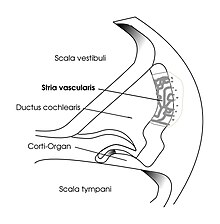Stria vascularis
The stria vascularis (Latin: "vascular stripe") is a stripe-shaped organ with an epithelial structure on the outer wall of the cochlear duct in the cochlea of the inner ear . It regulates the ion concentration of the endolymph .
It is the only epithelium in the human body that is vascularized and consists of three layers of different cells (basal cells, intermediate cells and marginal cells). The latter have a Na-K-2Cl cotransporter (NKCC1) basolaterally and a potassium channel apically , which enables potassium to flow from the marginal cells into the endolymph . As a result, the endolymph is strongly enriched with potassium and an electrical potential of approx. 80–90 mV ( endocochlear potential ) is formed between the endolymph and perilymph , which is of elementary importance for the transduction processes in the hair cells of the organ of Corti . The endothelial cells of the stria vascularis form the blood-labyrinth barrier, which not only maintains the ion concentration, but also prevents the passage of higher molecular substances into the inner ear.
If the NKCC1 channel is damaged or inhibited by ototoxic substances (e.g. with furosemide , a loop diuretic ), hearing losses of 30 to 50 dB result.
Web links
- www.cochlea.org Page about the ear, especially about the cochlea, Engl./Franz., Univ. Montpellier
Individual evidence
- ↑ a b James Byron Snow: Tinnitus: Theory and Management . PMPH-USA, 2004, ISBN 978-1-55009-243-1 , pp. 55 .
